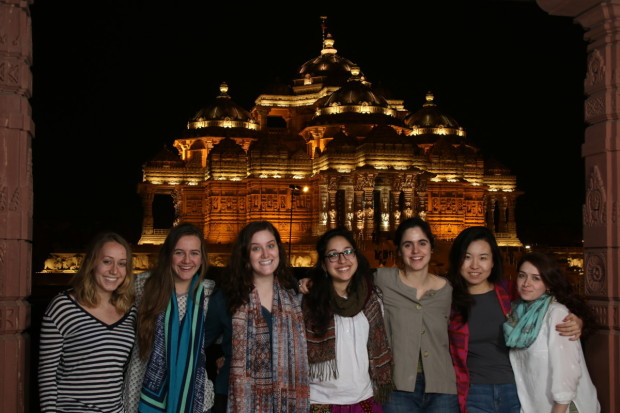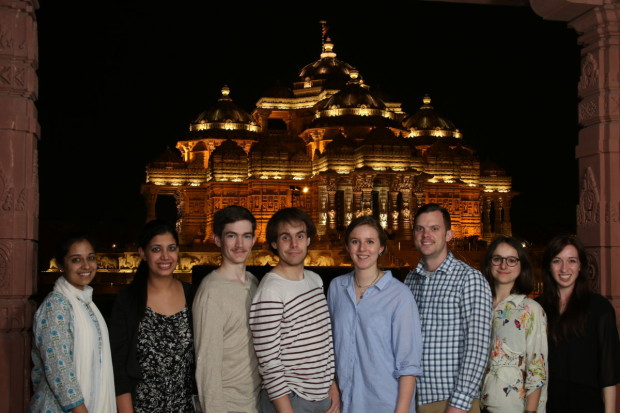NEW DELHI—Day three led to small reporting victories for our India Yatra team members as well as a spirited discussion amongst our group after we visited the BAPS Swaminarayan Akshardham.
As today was a reporting day for everyone, I thought that I would not have much to write about, but I could not be more wrong! To start my reporting day with Olivia, we interviewed an environmental science professor from Delhi University and then took a taxi to meet with members of an LGBT non-profit. Sunny, our Punjabi Sikh taxi driver for the trip, demonstrated that driving in India is a very complex yet choreographed ballet of cars orchestrated by drivers’ repetitive honking.
Meanwhile, a small group of students visited Robyn Beeche, a former London-based fashion photographer who now splits her time between New Delhi and Vrindavan, documenting life in various “Indias”. The group then went on a shopping excursion at Fab India, stocking up on local clothes and souvenirs. Jenna and Alice reported all day in the Braj region, which is considered the birthplace of Lord Krishna and one of the most important Hindu holy sites. There, they visited one of the biggest cows shelters in India, needless to say they were excited to shower after a day spent surrounded by cows.
On the other hand, Nathan’s reporting day was a succession of chaotic and seedy events. He took three different rickshaws, known as tuk-tuks in other parts of Asia. One driver offered him marijuana; another offered a call-girl and boasted of his four girlfriends for different days of the week. Nathan was trying to get in touch with the city’s Parsi community and arrived 200 feet away from the Zoroastrian temple but a gate, a security guard and the language barrier restricted him from reaching his goal.
The rest of the day was dedicated to the Swaminarayan Akshardham Mandir, probably one the most discussion-generating religious sites we have visited thus far. To enter the Akshardham visitors have to go through various security checkpoints and barbed wire fences surround the temple. No cameras, phones or bags are allowed on the premises. Since the 2002 attack on the Gandhinagar temple in Gujarat that killed 33 people and wounded 80 others, the temple has received numerous terrorist threats.
Our guide, Sunil Piplani, an engineer and worshiper who regularly dedicates the time to volunteer on site, first stopped at the 10 dwars, or gates. The ten gates symbolize the ten cardinal points from which the devotees receive “good thoughts [that] flow through their hearts.”
The 17-acre complex—built in a mere five years—was startling in its magnificence and splendor, transporting us back into the era of the Maharajas. It was not 2015 anymore, but 1781, the birth year of Lord Swaminarayan also known as Nilkanth Varni.
Every single ornament or statue is hand-carved into slabs of pink stone or Italian white marble using only ancient Indian building techniques that forgo steel or cement. On one particular gate, 869 peacocks are carved as a symbol of beauty and purity (it’s India’s national bird, too). On the gate of devotion, all 208 Hindus deities are portrayed, resulting in an auspicious darshan for the visitors.
The central Mandir was the most awe-inspiring part of the visit. The edifice is 145 feet high, with a total of nine unique sculpted domes and 20,000 original statues carved out of “one same stone,” according to Mr. Piplani. On the wooden doors, golden reliefs represent the large feet of Swaminarayan. Within, the darshan experience is breathtaking. The entire temple is decorated using pure white marble. A giant murti or sacred image of Lord Swaminarayan made of five different precious metals is displayed in the central room of the Akshardham Mandir. Here, devotees engage in darshan with their master in a golden alcove. Due to the crowds and the loud echoes, however, it was challenging to stay focused.
According to our guide, there were three purposes for Akshardham’s construction: the revival of Indic art, wisdom and culture. The temple offers an impressive robotics show and an IMAX movie that chronicles the life of Lord Swaminarayan. It’s also home to a Disneyland-esque boat water-tour offering “10,000 years of Indian culture in 10 minutes.” This raised some questions for me: how can a religious site double as a cultural theme park? Were we on a tourist excursion or a religious one? Even though we missed many important parts of the Akshardham since we were short on time, I did not have that transcendent feeling that I get in most religious sites. Perhaps it would have helped to see the smaller mandir where rituals takes place.
The nationalistic discourse of the tour (India and its many indigenous achievements were the central focus of the water-ride, for instance) also seemed to be juxtaposed with traces of western influence across the complex: popcorn stalls lined the grounds while an expansive gift-shop was a popular stop for many visitors. It occurred to me, though, that the two worlds aren’t as incompatible as they are often made out to be as visitors seemed to be navigating the experience seamlessly. That said, I could not help compare the grandeur of our Delhi experience to the far more understated visit we had in New York. During our visit to the Flushing BAPS mandir, our group participated in an aarti ritual and we were served traditional food. There we interacted, sang and clapped our hands with the devotees.
The other question that struck me had to do with the role that women play in the Swaminarayan faith: monks are prohibited from interacting directly with women due to vows of celibacy. Sadhu Gnanmunidas, an American-born swami we were introduced to, was one such monk. Our group includes ten female students, and the women were required to sit towards the back of the room. To make the situation more comfortable, both men and women in our group wrote out questions rather than asking them orally. Though the process proved to be a challenge for me and my fellow female classmates, it raised a larger point: how can female journalists negotiate patriarchal structures and still capture experiences accurately and thoroughly?
We ended our Akshardham excursion with a graciously prepared dinner at the in-house cafeteria and were joined by Bhavya Shrivastava of India TV, who reminded us of the important role that objectivity plays in religion reporting. His comments added to our growing understanding of empathetic objectivity, a theme that has repeatedly surfaced in numerous classroom discussions. Once again, this proved to be a crucial tool for us to process Akshardham, religion—and ultimately, India.

